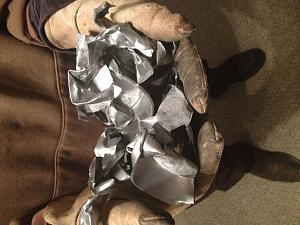Been lurking and reading here for a while learning what I could about casting. Today I finally got my WWs separated, had a good ratio of lead to Zn and Fe weights too. From 3 five gallon buckets I had 2.5 buckets of useable lead weights. Time for a smelt. Got the burner going, lead melted and fluxed with beeswax about three times. things are going great. Life is good. Even had a wonderful Christmas with the wife and boys. Time to load the ingot mold. I got me a cheap muffin tin for a mold. A 16 holer. Got all 16 cups filled and let them solidify for a minute. Need to dump 'em and reload. Enough lead in the pot for 10 or 12 more ingots. Turned the tin over and 3, yes 3 fell out. I know I'll slap in down gently on the concrete slab. That'll jar 'em loose. Well maybe if I do it a little harder. Yep they all fell out. Hold on here. The cups popped out of the frame. I bet I can pry 'em out with a screwdriver. Nope. Somebody put super glue in those 13 cups when I wasn't looking. Where are my tin snips. That got all of the tin off of my pretty lead ingots. This bullet casting is gonna be harder than I thought. Well I'm headed to WallyWorld to get a case of muffin tins so I can try again tomorrom. Ya'll know anything I might do different?


|
   
   
|


|



 Reply With Quote
Reply With Quote
























